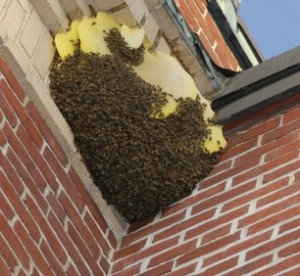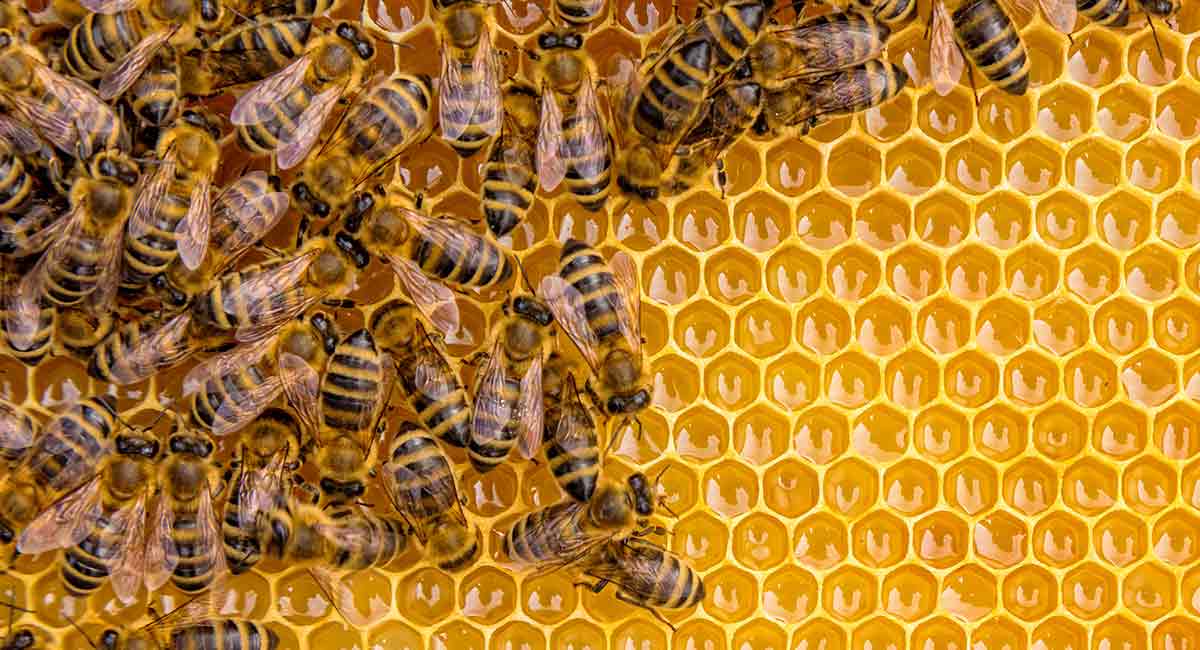When bees become a problem
What you need to know!
Honey bees have been associated with man for hundreds if not thousands of years.
These charming social insects provide us with a wonderfully natural source of sugary food and usually live alongside their human neighbours without conflict.
Occasionally however, bees do cause a problem and we need to take action. The most common situation we have to deal with where bees have come into conflict with humans, is the early summer bee swarm.
A dramatic event
It is natural for surplus queen bees to ‘leave home’ and bee-keepers take steps to prevent this happening. A well kept bee-hive will have had most surplus queens removed by the bee-keeper early in the year.
But from time to time an ‘extra’ queen will escape detection and in late spring or early summer she will leave the hive taking a large number of workers with her, in order to set up a new colony elsewhere.
A bee swarm is quite a dramatic event with tens of thousands of bees taking to the air in a thick dark noisy cloud. The swarm will often ‘settle’ several times before deciding on their permanent new home.
Each time the swarm ‘settles’ they pack down into a tight heaving mass of insects often suspended from a branch or bush. The bee swarm season typically starts in the first hot spell we experience in May.
What to do about garden swarms
Seeing a swarm for the first time can be frightening. The noise makes the bees sound angry whereas in fact nothing could be further from the truth. Swarming bees are only interested in following the queen and are rarely aggressive if left in peace.
However, it is a wise precaution to keep your distance, as if you trip or stumble right into the swarm you could be badly stung.
If the bees are still spread out in a big cloud over your garden, take any children and pets indoors and close the windows. If the bees decide to stay in your garden they will soon settle down into a much quieter, tightly packed mass no more than eighteen inches or so across.
Sometimes (especially if it is quite early in the day) the newly settled swarm will leave again quite quickly. You will normally hear a rapid increase in noise followed by the swarm rising up into the air and flying away to look for a better home.
Be careful not to let your children play in the garden again until you have seen the swarm leave or ascertained that the swarm has actually left. The settled swarm may pack together so tightly, and be so quiet, that you think they have gone when they are actually still there.
Occasionally the swarm will settle on the ground, more usually they will be higher up on a fence, bush or tree. Once they have settled down in this way, the bees can be carefully put in a box an moved by an expert.
A local bee-keeper will sometimes be willing to do this for you, otherwise you will need to call an experienced pest control contractor who will probably have an arrangement with a local bee-keeper to give him the swarm. There is normally no need to destroy these useful creatures where a swarm can be captured and moved in this way.
Please do not attempt to move the bees yourself. They may look very calm, all clustered together but they can take off again very quickly. Your pest control technician will make the bees ‘sleepy’ with smoke and wear appropriate protective clothing.
What about swarms in the chimney?
Sometimes a swarm will decide to make itself comfortable in your chimney. You may be tempted to simply leave them there because you won’t need your fireplace until the winter.
Unfortunately, once the bees have made themselves at home in the chimney, they are unlikely to move out again and it is better to deal with this problem straight away. Once bees have settled themselves into your home, they can be a serious problem
Don’t be tempted to light a fire to drive the bees away. Smoke simply sends bees to sleep and you are likely to end up with the entire swarm falling down the chimney and into your living room.
No-one wants to destroy bees but in some circumstances it is unavoidable. Call your pest control contractor and let him deal with the problem safely.
Established bee colonies in your property
It is unusual for bees to become established inside the fabric of a building, but once they do so, it can be an expensive and complex operation to remove them. They will build extensive honey comb in cavity walls and other crevices which may be inaccessible.
Because bees are very attracted to honey, even honey made by other bees, any honey left in the building will simply attract further bees which may arrive and take over the site, or carry any insecticide used back to their own hives.
It is not therefore a simple matter of killing the resident bees. All the honey comb and honey must be thoroughly stripped out and cleaned away, and as little insecticide residue left as possible.
Prompt action helps to save bees
For this reason, and to avoid harming the swarm, and any local hives, you should take action as soon as a swarm has clearly settled on your building. Swarms in your garden, especially if they arrive early in the day, will often take off again as it gets hotter.
Remember that there is nothing your pest control contractor can do until the bees have settled down into a tight bundle, but it is a good idea to contact him and let him know what has happened once the swarm has attached itself to a building, plant or tree. He may prefer to move the colony in the cool of the evening when the bees are calmer and less active.
To find out more about the life-cycle of bees visit: all about honey bees
For the very best in Professional Pest Control you can call us now on
01428 714031


Pingback: Is it a bee, or is it a wasp?